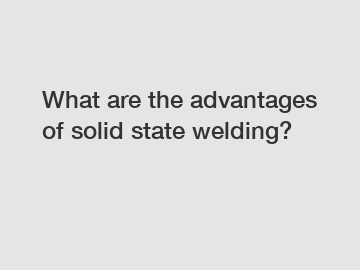What are the advantages of solid state welding?
Advancements in welding technology have revolutionized the industrial world. One such cutting-edge approach is solid state welding, a technique that offers numerous advantages over traditional methods. In this blog post, we will delve into the remarkable benefits of solid state welding, exploring its implications for various industries and highlighting its unique characteristics.
Solid state welding, as the name suggests, involves joining two materials without the need for melting them. Rather than relying on molten metal to fuse the components together, solid state welding employs pressure and heat to form a strong bond between the materials. This technique is particularly advantageous for certain applications, as it eliminates the potential weaknesses associated with thermal stress and distortion that can occur in conventional welding processes.
One of the key advantages of solid state welding is the ability to join dissimilar materials. Unlike other welding methods, solid state welding can seamlessly join materials with differing chemical compositions and physical properties. This versatility opens up new possibilities for industries such as aerospace, automotive, and electronics, where components made from different metals or alloys need to be combined effortlessly and securely.

The impeccable strength of solid state welds is another major advantage. The absence of a molten phase ensures that the solidified joint is free from detrimental microstructural changes that can weaken the weld. Consequently, solid state welds possess exceptional integrity, exhibiting mechanical properties comparable to those of the base materials. This robust bond guarantees enhanced structural integrity and superior performance in critical applications, fostering durability and reliability.
Additionally, solid state welding minimizes the need for consumables such as filler materials and fluxes. This not only reduces material costs but also eliminates the potential for harmful by-products and fumes associated with consumable-based welding processes. The absence of these hazardous elements makes solid state welding an environmentally friendly choice, aligning with sustainability goals and regulations.
One fascinating aspect of solid state welding is its adaptability to different production scales. From microjoining delicate electronic components to macrojoining large structures, this technique can be tailored to meet specific requirements. It allows for precise control over the welding parameters, ensuring a consistent quality of joints. This flexibility makes solid state welding an attractive solution for industries striving to optimize their manufacturing processes and achieve high production efficiency.
Moreover, solid state welding offers significant time and cost savings. The absence of molten metal and the elimination of filler materials reduce the complexity associated with conventional welding processes. This simplification translates into shorter production cycles, decreasing operational costs and labor requirements. As a result, industries employing solid state welding can experience improved productivity and profitability.
In terms of aesthetics, solid state welding delivers flawless, cosmetically appealing joints. The absence of excessive heat results in minimal distortion, preserving the structural integrity and surface finish of the materials being joined. This advantage makes solid state welding an ideal choice for applications where appearance matters, such as architectural structures or consumer goods.
Furthermore, solid state welding brings a new level of safety to the welding process. With no molten metal or open flames involved, the risk of accidents and injuries associated with conventional welding techniques is significantly reduced. Employing solid state welding methods not only safeguards the well-being of workers but also eliminates the potential for fire hazards in workplaces.
In conclusion, the advantages of solid state welding are vast and multifaceted. Its ability to join dissimilar materials, produce robust and defect-free welds, minimize environmental impact, offer adaptability and productivity, enhance aesthetics, and prioritize safety make it an enticing choice for various industries. As technology continues to advance, solid state welding will undoubtedly play a pivotal role in shaping the future of manufacturing and engineering, driving innovation and efficiency to new heights.
Are you interested in learning more about China 100kw solid state hf welder manufacturer, China connecting rod induction annealing equipment manufacturers, high frequency solid state welder? Contact us today to secure an expert consultation!

Comments
0